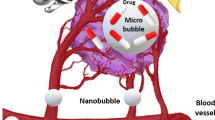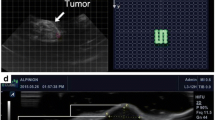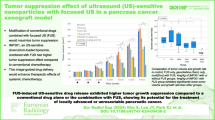Abstract
Purpose
The therapeutic effect of ultrasound and micellar-encapsulated doxorubicin was studied in vivo using a tumor-bearing rat model with emphasis on how tumor growth rate is affected by ultrasonic parameters such as frequency and intensity.
Methods
This study employed ultrasound of two different frequencies (20, 476 kHz) and two pulse intensities, but identical mechanical indices and temporal average intensities. Ultrasound was applied weekly for 15 min to one of two bilateral leg tumors (DHD/K12/TRb colorectal epithelial cell line) in the rat model immediately after intravenous injection of micelle-encapsulated doxorubicin. This therapy was applied weekly for 6 weeks.
Results
Results showed that tumors treated with drug and ultrasound displayed, on average, slower growth rates than non-insonated tumors (P = 0.0047). However, comparison between tumors that received 20 or 476-kHz ultrasound treatments showed no statistical difference (P = 0.9275) in tumor growth rate.
Conclusion
Application of ultrasound in combination with drug therapy was effective in reducing tumor growth rate, irrespective of which frequency was employed.

Similar content being viewed by others
Abbreviations
- Dox:
-
Doxorubicin
- IP:
-
Intraperitoneal
- MI:
-
Mechanical index
- SC:
-
Subcutaneous
- TV:
-
Tumor volume
- US:
-
Ultrasound
References
Husseini GA, Pitt WG (2008) Micelles and nanoparticles in ultrasonic drug and gene delivery. Adv Drug Deliv Rev 60:1137–1152
Husseini GA, Pitt WG (2009) Ultrasonic-activated micellar drug delivery for cancer treatment. J Pharm Sci (in press). doi:10.1002/jps.21444
Rapoport N, Pitt WG, Sun H, Nelson JL (2003) Drug delivery in polymeric micelles: from in vitro to in vivo. J Control Rel 91:85–95
Husseini GA, de la Diaz Rosa MA, Gabuji T, Zeng Y, Christensen DA, Pitt WG (2007) Release of doxorubicin from unstabilized and stabilized micelles under the action of ultrasound. J Nanosci Nanotech 7:1–6
Pruitt JD, Pitt WG (2002) Sequestration and ultrasound-induced release of doxorubicin from stabilized pluronic P105 micelles. Drug Deliv 9:253–258
Rapoport N, Gao ZG, Kennedy A (2007) Multifunctional nanoparticles for combining ultrasonic tumor imaging and targeted chemotherapy. J Natl Cancer Inst 99:1095–1106
Husseini GA, Pitt WG (2008) The use of ultrasound and micelles in cancer treatment. J Nanosci Nanotechnol 8:2205–2215
Huang S (2008) Liposomes in ultrasonic drug and gene delivery. Adv Drug Deliv Rev 60:1167–1176
Frenkel V, Etherington A, Greene M, Quijano J, Xie JW, Hunter F, Dromi S, Li KCP (2006) Delivery of liposomal doxorubicin (Doxil) in a breast cancer tumor model: Investigation of potential enhancement by pulsed-high intensity focused ultrasound exposure. Acad Radiol 13:469–479
Dromi S, Frenkel V, Luk A, Traughber B, Angstadt M, Bur M, Poff J, Xie JW, Libutti SK, Li KCP, Wood BJ (2007) Pulsed-high intensity focused ultrasound and low temperature sensitive liposomes for enhanced targeted drug delivery and antitumor effect. Clin Cancer Res 13:2722–2727
Kheirolomoom A, Dayton PA, Lum AFH, Little E, Paoli EE, Zheng H, Ferrara KW (2007) Acoustically-active microbubbles conjugated to liposomes: characterization of a proposed drug delivery vehicle. J Controll Release 118:275–284
Larina IV, Evers BM, Bartels C, Ashitkov TV, Larin KV, Esenaliev RO (2002) Ultrasound-enhanced drug delivery for efficient cancer therapy. Presented at Joint Meeting of the IEEE Engineering in Medicine and Biology Society and The Biomedical Engineering Society, Houston, TX
Ivanoa Y, Evers BM, Thomas R, Ashitkov TV, Esenaliev RO (2002) Nanoparticles and ultrasound for delivery of model macromolecular anti-cancer drugs in tumors. Presented at Joint Meeting of the IEEE Engineering in Medicine and Biology Society and The Biomedical Engineering Society, Houston, TX
Crowder KC, Hughes MS, Marsh JN, Barbieri AM, Fuhrhop RW, Lanza GM, Wickline SA (2005) Sonic activation of molecularly-targeted nanoparticles accelerates transmembrane lipid delivery to cancer cells through contact-mediated mechanisms: Implications for enhanced local drug delivery. Ultrasound Med Biol 31:1693–1700
Larina IV, Evers BM, Ashitkov TV, Bartels C, Larin KV, Esenaliev RO (2005) Enhancement of drug delivery in tumors by using interaction of nanoparticles with ultrasound radiation. Technol Cancer Res Treat 4:217–226
Chumakova OV, Liopo AV, Andreev VG, Cicenaite I, Evers BM, Chakrabarty S, Pappas TC, Esenaliev RO (2008) Composition of PLGA and PEI/DNA nanoparticles improves ultrasound-mediated gene delivery in solid tumors in vivo. Cancer Lett 261:215–225
Hosseinkhani H, Aoyama T, Ogawa O, Tabata Y (2002) Liver targeting of plasmid DNA by pullulan conjugation based on metal coordination. J Controll Release 83:287–302
Hosseinkhani H, Aoyama T, Ogawa O, Tabata Y (2002) Ultrasound enhancement of in vitro transfection of plasmid DNA by a cationized gelatin. J Drug Target 10:193–204
Hosseinkhani H, Tabata Y (2005) Ultrasound enhances in vivo tumor expression of plasmid DNA by PEG-introduced cationized dextran. J Controll Release 108:540–556
Aoyama T, Hosseinkhani H, Yamamoto S, Ogawa O, Tabata Y (2002) Enhanced expression of plasmid DNA–cationized gelatin complex by ultrasound in murine muscle. J Controll Release 80:345–356
Hosseinkhani H, Kushibiki T, Matsumoto K, Nakamura T, Tabata Y (2006) Enhanced suppression of tumor growth using a combination of NK4 plasmid DNA-PEG engrafted cationized dextran complex and ultrasound irradiation. Cancer Gene Ther 13:479–489
Frenkel V (2008) Ultrasound mediated delivery of drugs and genes to solid tumors. Adv Drug Deliv Rev 60:1193–1208
Wu JR, Nyborg WL (2008) Ultrasound, cavitation bubbles and their interaction with cells. Adv Drug Deliv Rev 60:1103–1116
Sboros V (2008) Response of contrast agents to ultrasound. Adv Drug Deliv Rev 60:1117–1136
Brennen CE (1995) Cavitation and bubble dynamics. Oxford University Press, New York
Prentice P, Cuschierp A, Dholakia K, Prausnitz M, Campbell P (2005) Membrane disruption by optically controlled microbubble cavitation. Nat Phys 1:107–110
Barnett S (1998) Thresholds for nonthermal bioeffects: theoretical and experimental basis for a threshold Index. Ultrasound Med Biol 24:S41–S49
Bouakaz A, Versluis M, de Jong N (2005) High-speed optical observations of contrast agent destruction. Ultrasound Med Biol 31:391–399
Husseini GA, Diaz MA, Richardson ES, Christensen DA, Pitt WG (2005) The role of cavitation in acoustically activated drug delivery. J Controll Release 107:253–261
Husseini GA, Myrup GD, Pitt WG, Christensen DA, Rapoport NY (2000) Factors affecting acoustically-triggered release of drugs from polymeric micelles. J Controll Release 69:43–52
Husseini GA, Rapoport NY, Christensen DA, Pruitt JD, Pitt WG (2002) Kinetics of ultrasonic release of doxorubicin from Pluronic P105 micelles. Coll Surf B Biointerf 24:253–264
Husseini GA, Runyan CM, Pitt WG (2002) Investigating the mechanism of acoustically activated uptake of drugs from Pluronic micelles. BMC Cancer 2:20
Marin A, Muniruzzaman M, Rapoport N (2001) Acoustic activation of drug delivery from polymeric micelles: effect of pulsed ultrasound. J Controll Release 71:239–249
Munshi N, Rapoport N, Pitt WG (1997) Ultrasonic activated drug delivery from Pluronic P-105 micelles. Cancer Lett 117:1–7
Nelson JL, Roeder BL, Carmen JC, Roloff F, Pitt WG (2002) Ultrasonically activated chemotherapeutic drug delivery in a rat model. Cancer Res 62:7280–7283
Pruitt JD, Husseini G, Rapoport N, Pitt WG (2000) Stabilization of Pluronic P-105 micelles with an interpenetrating network of N,N-diethylacrylamide. Macromolecules 33:9306–9309
Jacquet P, Stuart OA, Dalton R, Chang D, Sugarbaker PH (1996) Effect of intraperitoneal chemotherapy and fibrinolytic therapy on tumor implantation in wound sites. J Surg Oncol 62:128–134
Martin F, Caignard A, Jeannin JF, Leclerc A, Martin M (1983) Selection by trypsin of two sublines of rat colon cancer cells forming progressive or regressive tumors. Int J Cancer 32:623–627
Myhr G, Moan J (2006) Synergistic and tumour selective effects of chemotherapy and ultrasound treatment. Cancer Lett 232:206–213
Nelson JL (2002) Ultrasonically enhanced drug delivery of doxorubicin in vivo from stabilized pluronic micelle carriers, in chemical engineering. Brigham Young University, Provo, p 79
Staples BJ, Pitt WG, Schaalje B, Roeder BL (2007) Ultrasonically-assisted drug delivery in rats reduces tumor growth. Presented at Controlled Release Society, Long Beach, CA
Pitt WG, Husseini GA, Staples BJ (2004) Ultrasonic drug delivery—a general review. Expert Opin Drug Deliv 1:37–56
Draper DO, Castel JC, Castel D (1995) Rate of temperature increase in human muscle during 1 MHz and 3 MHz continuous ultrasound. J Orthop Sports Phys Ther 22:142–150
Kennedy JE, Ter Haar GR, Cranston D (2003) High intensity focused ultrasound: surgery of the future? Br J Radiol 76:590–599
Mitragotri S, Blankschtein D, Langer R (1995) Ultrasound-mediated transdermal protein delivery. Science 269:850–853
Mitragotri S, Kost J (2004) Low-frequency sonophoresis. A review. Adv Drug Deliv Rev 56:589–601
Qian Z, Sagers RD, Pitt WG (1997) The effect of ultrasonic frequency upon enhanced killing of P. aeruginosa biofilms. Ann Biomed Eng 25:69–76
Peterson RV, Pitt WG (2000) The effect of frequency and power density on the ultrasonically-enhanced killing of biofilm-sequestered Escherichia coli. Coll Surf B Biointerf 17:219–227
Staples BJ (2007) Pharmacokinetics of ultrasonically-released, micelle-encapsulated doxorubicin in the rat model and its effect on tumor growth. Chemical Engineering Department, Brigham Young University, Provo, UT
Staples BJ, Roeder BL, Pitt WG (2006) Doxorubicin delivery to rat tissues using polymeric micelles and ultrasound. Presented at Annual Meeting of the Society for Biomaterials. Pittsburgh, PA, USA
Staples BJ, Roeder BL, Husseini GA, Badamjav O, Schaalje GB, Pitt WG (2009) Distribution of doxorubicin in rats subjected to ultrasonic cancer therapy (in review)
Tanaka T, Shiramoto S, Miyashita M, Fujishima Y, Kaneo Y (2004) Tumor targeting based on the effect of enhanced permeability and retention (EPR) and the mechanism of receptor-mediated endocytosis (RME). Int J Pharm 277:39–61
Seymour LW (1992) Passive tumor targeting of soluble macromolecules and drug conjugates. Crit Rev Ther Drug Carrier Syst 9:135–187
Reddy LH (2005) Drug delivery to tumours: recent strategies. J Pharm Pharmacol 57:1231–1242
Kruskal J, Goldberg S, Kane R (2001) Novel in vivo use of conventional ultrasound to guide and enhance molecular delivery and uptake into solid tumors. Presented at Annual Meeting of the Radiological Society of North America, Chicago, IL
Kruskal J, Miner B, Goldberg SN, Kane RA (2002) Optimization of conventional clinical ultrasound parameters for enhancing drug delivery into tumors. Radiology 225:587–588
Schlicher RK, Radhakrishna H, Tolentino TP, Apkarian RP, Zarnitsyn V, Prausnitz MR (2006) Mechanism of intracellular delivery by acoustic cavitation. Ultrasound Med Biol 32:915–924
Hallow DM, Mahajan AD, Prausnitz MR (2007) Ultrasonically targeted delivery into endothelial and smooth muscle cells in ex vivo arteries. J Controll Release 118:285–293
Nyborg WL (2001) Biological effects of ultrasound: development of safety guidelines. Part II: General review. Ultrasound Med Biol 27:301–333
Acknowledgment
Funding for this research was provided by the NIH (CA98138).
Conflict of interest statement
None.
Author information
Authors and Affiliations
Corresponding author
Rights and permissions
About this article
Cite this article
Staples, B.J., Roeder, B.L., Husseini, G.A. et al. Role of frequency and mechanical index in ultrasonic-enhanced chemotherapy in rats. Cancer Chemother Pharmacol 64, 593–600 (2009). https://doi.org/10.1007/s00280-008-0910-8
Received:
Accepted:
Published:
Issue Date:
DOI: https://doi.org/10.1007/s00280-008-0910-8




